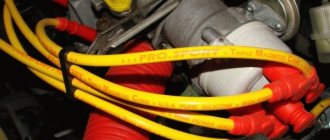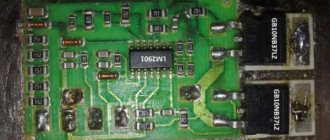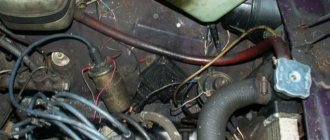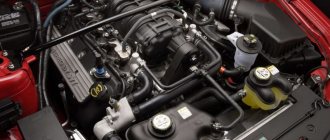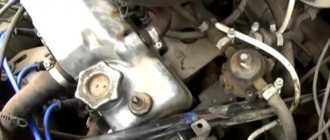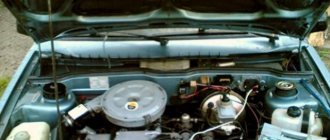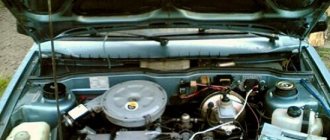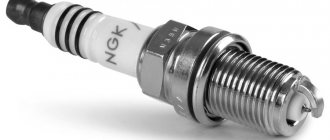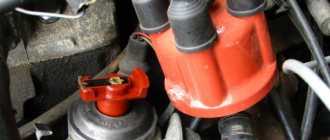Examination
If you notice signs of a problem with the ignition coil, or have to deal with a situation where the engine “died,” be sure to check the condition of this element.
As you test, you will be able to determine what caused the coil to fail and how the problems can be corrected.
https://youtube.com/watch?v=Z5cUQhKBZm0
Ignition coil
How to check the device? The instructions are not complicated, even a beginner can handle it.
First, let's check the condition of the unit, and then check for correctness of the resistance of the coil itself.
- If the engine cannot be started, make sure that the coil itself is producing a spark at all. To do this, the central wire is removed from the distributor and a spare spark plug is connected to it.
- Now take the spark plug with pliers and place the metal casing on the breaker or motor.
- If a spark does not appear when the engine starter is turned, there is a malfunction in the ignition system.
- So check the power to the coil, or rather its presence. For this you will need a multimeter. One terminal is connected to contact B on the coil, and the second goes to ground. Turn on the ignition. If there is no voltage, the culprit is the ignition switch.
- You can start the engine in emergency mode. To do this, the plus from the battery is thrown onto contact B of the coil.
If there is voltage but there is no spark, check whether the primary winding is intact. To do this, the side low-voltage wires are disconnected from the coil and resistance measurements are taken with a multimeter. Then the secondary winding is checked.
ignition coil
We will tell you about this procedure in more detail.
Multimeter for testing
Checking coil resistance
- Unplug your car. To do this, simply disconnect the negative terminal from the battery.
- Disconnect all wires and leads going to and from the coil.
- Be sure to arm yourself with the necessary tools and a tester. A universal multimeter or ohmmeter will work fine.
- Take measurements on the primary winding. To do this, the tester probes must be connected to the low-voltage terminals located at the edges of the coil. Before doing this, do not forget to clean the terminals from accumulated dirt and traces of oxidation. Surely they formed during the operation of the car.
- Record the data.
- Now the resistance of the secondary winding is checked. To do this, you need to transfer one ohmmeter probe to terminal B of the coil, and the second to the high voltage.
- Note your results.
- The last stage of the test involves measuring the insulation resistance to ground. To do this, you need to connect one terminal of your tester to ground (this is the ignition coil housing), and connect the second one in turn to all three terminals - a pair of low-voltage terminals and one high-voltage one located in the middle of the device. If the coil is working properly, then in all three measurement cases you will get a resistance of at least 50 ohms.
- Check the table against the previously recorded data.
[media= https://www.youtube.com/watch?v=2F4BDExybgs]
| Coil type | Winding | Resistance indicators |
| 3122.3705 | Primary winding | 0.43 ohms +/- 0.04 ohms |
| 8352.12 | 0.42 ohm +/- 0.05 ohm | |
| 3122.3705 | Secondary winding | 4.08 ohms +/- 0.40 ohms |
| 8352.12 | 5.00 ohms +/- 1.00 ohms |
We measure the resistance of the ignition coil
Repair
In fact, the only way to repair a faulty ignition coil on a carburetor or injection VAZ 2109 is to replace the device.
Here you just need to choose which element will replace your old coil.
- MZATE-2. This is a standard coil, which all VAZ 2109s were equipped with from the factory. It costs about 600 rubles and serves well;
- An excellent alternative option, characterized by reliability, durability and operational efficiency. But it costs about 1800-2000 rubles;
- Valeo. Something between the factory and Bosch version, which has good characteristics and positive reviews. Today such a reel costs an average of 1,500 rubles.
The coil is the most important element of the ignition system; if it fails, you can forget about traveling about your business.
How to check an ignition coil: 3 proven methods
Loading …
Verification procedure
If you detect one or more signs of “dying” of the coil or if it is impossible to start the engine, you should definitely check its performance. This is necessary in order to find out what nature of the breakdown occurred, and, therefore, begin to eliminate it.
Can this be done without instruments? Unfortunately no. Unless you immediately replace the coil with a known good one. At the very least, a regular multimeter will suffice. Such a tester must be kept in the car - its cost is almost symbolic.
In general, verification is relatively easy. It is enough to follow the steps described below, and even a completely inexperienced car enthusiast can handle it.
First of all, you need to inspect the ignition unit itself. If the engine does not start at all, then you need to find out if there is a spark. You need to do this:
- disconnect the main wire from the distributor (located in the center);
- connect a candle to it;
- holding it with pliers, apply it to the motor housing or to the breaker;
- turn on the ignition.
If there is no spark, there is only one conclusion - failure in the coil. Next, you need to find out whether electricity is supplied to it.
The check is carried out with a multimeter. One of its probes is applied to terminal “B” on the coil, the second to ground. If there is no voltage after turning on the ignition, the fault is looked for directly in the lock.
In addition, it is also possible to power the coil using an emergency circuit. Here the wire from the positive terminal of the battery is connected to contact “B”. In this situation, you can be absolutely sure that voltage is supplied. However, when these actions did not lead to a spark, you will have to test the primary winding for integrity.
For this:
- the wiring located on its sides is disconnected (they are low-voltage);
- the multimeter is set to Ohms and the resistance is measured;
- The secondary winding is also ringed in the same way.
Checking the ignition coil on VAZ 2108, 2109, 21099 cars
If such malfunctions occur in the operation of the engine of VAZ 2108, 2109, 21099 cars such as the disappearance of a spark or a weak spark, unstable idling, inability to adjust idle speed, difficult starting or impossibility of starting the engine, failures and jerks when starting and in motion, etc., It makes sense to check the functionality of the ignition coil.
Required Tools
- 8 mm spanner or open-end wrench
— a tester (multimeter or similar device) with an ohmmeter mode (preferably also a megohmmeter)
Preparatory work
You can check the ignition coil on VAZ 2108, 2109, 21099 cars without removing it from the car.
- remove the negative terminal from the battery
- disconnect the high-voltage wire from the ignition coil
- disconnect the wires leading to the two terminals of the coil
To do this, use an 8 mm wrench to unscrew the nuts securing the wires to terminals “K” and “B”. We disconnect the wires, remembering their position, so as not to confuse them when installing them back.
— Check the serviceability of the primary winding of the ignition coil
Checking the primary winding of the ignition coil of VAZ 2108, 2109, 21099 To do this, connect one tester probe to terminal “B” and the second probe to terminal “K” - the terminal of the primary winding. We turn on the device in ohmmeter mode. The resistance of a serviceable primary winding of the ignition coil should be close to zero (0.4 - 0.5 Ohm). If it is lower, then there is a short circuit, if higher, there is a “break” in the winding.
— Check the serviceability of the secondary (high-voltage) winding of the ignition coil
Checking the secondary winding of the ignition coil of VAZ 2108, 2109, 21099 To do this, connect one tester probe to terminal “B” of the ignition coil, and the second probe to the terminal for the high-voltage wire. We measure resistance. For a working secondary winding it should be 4.5 - 5.5 kOhm.
— Check the insulation resistance to ground
For such a test, it is necessary that the multimeter has a megohmmeter mode (or a separate megohmmeter is needed) and can measure significant resistance.
To do this, we attach one tester probe to terminal “B” of the ignition coil, and press the second probe to its body. The insulation resistance must be very high - 50 mOhm or higher.
If at least one of the three checks shows a malfunction, the ignition coil should be replaced.
Notes and additions
— Ignition coils installed on VAZ 2108, 2109, 21099 cars can be of two types: dry with a closed magnetic circuit (3122.3705) and oil-filled with an open magnetic circuit (8352.12, 027.3705, 27.3705, 27.3707-01, ATE1721). The winding resistances for them are slightly different. Coil 3122.3705 – primary winding 0.43±0.04 Ohm, secondary 4.08±0.4 kOhm. Coils 8352.15, etc. – primary winding 0.42±0.05 Ohm, secondary 5±1 kOhm. Measurements were carried out at +25 degrees.
Twokarburators VK - More information on the topic in our VKontakte group, on Facebook Twokarburators FS, in Odnoklassniki - Twokarburators OK and in Yandex Zen - Twokarburators DZ
— The procedure for connecting high-voltage wires to the distributor cover on VAZ 2108, 2109, 21099 cars
— Malfunctions of the contactless ignition system of VAZ 2108, 2109, 21099 cars
— Malfunctions of the distributor of VAZ 2108, 2109, 21099 cars
— Checking high-voltage wires on VAZ 2108, 2109, 21099 cars
— Setting the ignition timing on the engines of VAZ 2108, 2109, 21099 cars
Comparative test repair
— Checking the ignition coil of the ignition system of carburetor engines of VAZ 2101, 2102, 2103, 2104, 2105, 2106, 2107 cars
Ignition coil malfunctions
The main types of ignition coil malfunctions include:
- A short circuit between the turns of any of the windings of the product.
- A break in the electrical circuit of the primary or secondary windings.
- Insulation breakdown of the secondary winding on the body of the device.
- There is a lubricant leak on the product cover.
- Defects on the device cover.
- Incorrect values of the measuring device when measuring the resistance value of the ignition coil of any winding.
With such above defects, the coil must be replaced. A qualitative check of the ignition coil is divided into several tests. These include:
- testing the product resistance in both circuits;
- testing the resistance of the device to the “mass” of the device.
To carry out the test, two conditions must be met: the external temperature must be in the range of 20-25 degrees Celsius and the presence of a measuring device - a megger. We connect the “crocodiles” of the device to the contacts of the product on the right and left and take measurements in the selected range. The winding resistance should be within the range of 0.4-0.5 Ohms. If the measurement value is different, the ignition coil must be replaced with an updated product.
To carry out the test, you need to connect the alligator clips to connector “B” and to the central contact. At the previously determined temperature value of the atmosphere, the measuring device in the given register should show 4.5-5.5 kOhm. If the measurement value of the “nine” ignition coil is different, then the device must be replaced with an updated product.
To test the resistance of the device to ground, one contact is attached to the body of the VAZ 2109 ignition coil, and the other to each output of the product in turn. When taking measurements, the megger must produce a value of at least 50 mOhm in the corresponding register. If the measurement indicator is different, the Lada coil of the ninth model must be replaced with an updated product.
Despite the fact that this “nine” ignition complex is not particularly difficult for a specialist, the principle of its operation is based on the fundamentals of electromagnetic induction and electrical phenomena. This makes it necessary to approach its diagnosis with a certain amount of knowledge in these areas.
In theory, everything turns out quite simply, but a number of car enthusiasts offer an alternative way to increase the functionality of the ignition coil by “nine”. They propose to replace the reel with a product with item number B-117, and replace the set of candles with a set of other products indexed in the number with the same name, but without the letter “P”. These experts assure the excellent reliability of this replacement and report that all the advantages of the contactless ignition system are preserved. The owners of the “nines” will have to make a decision!
Ignition coil
VAZ
2109
. system check
If suddenly the engine starts to stall, the power disappears, or the car won't start at all, the problem most likely lies with the ignition system. If we are talking about a VAZ 2109 carburetor engine, then the ignition system can be corrected even by a beginner. First, you should check the coil
ignition VAZ 2109, trampler, high-voltage wires, etc.
To check the ignition system, you need a multimeter, a Phillips and flathead screwdriver, and pliers with insulated handles. To set the ignition timing, you may need a 12V lamp with socket. To test for spark, you will need one accurately working spark plug, as it is strongly recommended not to test for spark from wire to ground.
When repairing the ignition system on a VAZ 2109, you can get a very unpleasant, but not fatal, electric shock from a high-voltage wire. To prevent this from happening, do not handle high-voltage wires with your bare hands while the ignition is on. For these purposes, it is best to use thick rubber gloves or insulated pliers.
Flooding when there is a spark and the starter is rotating
Experienced motorists are faced with situations when a spark appears, the starter rotates, but the lower part of the spark plugs is filled with gasoline. Do not be deluded by the presence of a fire, since this event can occur irregularly under pressure and can be lost while the engine is running.
The cause of the event appears to be excessive pressure in the cylinders. It will be possible to identify the event and the factors that motivate it by monitoring the car on a stand that simulates a combustion chamber.
We recommend paying attention to the valve timing, because their failure will be the cause of wet electrodes. In injection internal combustion engines, motorists should check the functionality of the bypass valve located on the fuel rail. If its malfunctions are ruled out, you will need to find out the gasoline pressure in the rail, because the manufacturer regulates this parameter
Sharp fluctuations and going beyond the specified interval (larger/smaller sides) can block the start of the internal combustion engine or stimulate flooding of contacts for spark ignition
If its malfunctions are ruled out, you will need to find out the gasoline pressure in the rail, because the manufacturer regulates this parameter. Sharp fluctuations and going beyond the specified interval (larger/smaller sides) can block the start of the internal combustion engine or stimulate flooding of contacts for spark ignition.
Diagnostics will need to be carried out for the sensors of the electronic control system and for the injectors. An example of a failure is when the coolant temperature sensor sends incorrect data. In such a situation, the control unit unreasonably over-enriches the fuel mixture. Much less often, the culprit of incorrect impulses is a failed electronic control unit or a malfunction of its software. In this case, problems will appear not only with the ignition.
Ignition settings
When setting up the ignition, you will need to do the most important thing - install the shafts according to the marks so that the gas distribution functions synchronously with the operation of the piston group. This is the first thing you should do before you start adjusting the ignition. It is worth noting that there should not be any particular difficulties during setup, especially on VAZ 2108-21099 cars. The thing is that the ignition distributor on the engines of these machines can only be installed in one position. Moreover, the ignition switch does not undergo any settings during this procedure, since it does not have any. The distributor body rotates around its axis to make more precise adjustments. And this turns out to be enough. To accurately set the torque, you can use a simple circuit that uses a simple LED as an indicator. The Hall sensor is disconnected from the system, and positive power is supplied to its negative terminal. An LED is switched on between “+” and the signal LED, and a 2 kOhm resistance is connected in series with it to reduce the voltage. But the plus of the Hall sensor is connected to ground. Now all that remains is to slowly rotate the distributor housing. The moment when the diode lights up will be the desired one.
How to replace the ignition module on a VAZ 2108-VAZ 21099
1) The module is not difficult to remove, but there will be problems with checking it, because first of all, special equipment is needed for this, although using a conventional multi-meter you can check the module for functionality (We will describe how the module can be checked in this same article), but first you need to remove it, to do this, first disconnect the wire block from the module (see photo 1) which is attached to it by a latch, so don’t forget to bend the latch on the block, otherwise you can break it off as soon as the block will be disconnected, pick up a wrench and use it to completely unscrew the upper bolt (see photo 2) of the module fastening, then unscrew the side nut (see photo 3, indicated by the red arrow) of the bolt and so as not to lose the bolt, you can remove it like this well, and finally, move lower (Under the car if you can) and there look for the last bolt securing the module in the lower part (see photo 4, the bolt is indicated by an arrow), loosen this bolt a little and then completely remove the ignition module from the car, with To do this, disconnect all four wires that are connected to it, otherwise they will not allow you to remove the module from the car.
THIS IS ONLY ONE METHOD FOR CHECKING A MODULE
!!! DO NOT RUN FOR A NEW IMMEDIATELY!!! THERE ARE MORE METHODS, THIS IS.
https://youtube.com/watch?v=4wHGBUx6x3M
In general, when working with the module, it is recommended to de-energize the on-board system (the network is de-energized by removing the minus terminal from the battery; if you don’t know how to remove the terminal, read the article: “Replacing the battery”, everything is written in paragraph one of that article), you never know what can happen, so safety is paramount, but before de-energizing the system, check the wiring block that is connected to the module and after that you can de-energize it, to check, disconnect it and turn the ignition key until all the devices in the car light up as soon as they light up they pick up a multi-meter and turn on the voltmeter mode on it and measure the voltage on the block, to do this, connect two wires coming from the multi-meter, connect one of the wires to the terminal that is marked (see the wire block, it has these markings on it ) with the letter C, and the other which is marked with the letter D and the device should show a voltage of 12 V, if it shows less or does not show anything at all, then either the battery is discharged or the wiring is faulty, but to check the ignition module itself it is better to do this either using a special device, or changing it to a known-good module, taking it from a neighbor as an example (If he has the same car), or using the same multi-meter, you can try (But even a multi-meter can show incorrect results, therefore, do not rely too much on this method), read about how to do this in the article: “Replacing the module and coil on a VAZ”, namely in that article the item “Note!” read it!
2) Now that the module has been removed, disconnect it from the bracket; to disconnect it, use a wrench and a socket head of a suitable size; in total, the module is attached to the bracket with three nuts (see photo 1), unscrew all these nuts and then you can disconnect the module from the bracket (see photo 2).
1. The new module is installed in its place in the reverse order of removal, but only when installing, first align the new module with the bracket by tightening the three nuts that secure the module to the bracket and something else, when the module is put in its place, the high-voltage wires that you got from the old one disconnected to a new one, you need to connect it in a certain order, that is, on each wire there is a number from 1 to 4 (see small photo below), on the module itself these numbers are also there (Red arrows are indicated, but unfortunately the number 2 is not visible, because her small photo is covered), in addition, with these numbers on the module there are pins (Indicated by blue arrows) to these pins and high-voltage wires must be connected, so connect all the wires to these pins so that the numbers match (That is, the first wire, to pin one, the second wire to terminal two, etc.), if there is a mismatch, the car will not work correctly and may not even start.
How to check the ignition coil?
Before checking the ignition coil in a VAZ 21099 injector or carburetor, you need to prepare a tester (multimeter) and disconnect the battery from the power supply. Checking the switching on of the device, its connection and connection can be carried out without dismantling the short circuit.
Diagnostics of the performance of a short circuit on the 21099 injector includes the following steps:
- First you need to disconnect the high-voltage wires that go to the short circuit terminals. To do this, use a size 8 wrench and unscrew the nuts securing the cables to terminals K and B. Before disconnecting the wires, you must remember their position; under no circumstances should they be mixed up during further installation!
- Next, the ignition coil is directly checked, in particular the primary winding. To do this, connect one multimeter probe to terminal B and the other to terminal K on the primary. Having done this, you can activate the multimeter in ohmmeter mode. If the primary is serviceable, then the resistance level as a result of diagnostics should be about 0.4-0.5 Ohm.
- The next step will be to diagnose the secondary structural element; this will also require a multimeter. To check the serviceability of this component, you need to connect one lead of the multimeter to pin B of the short circuit, and the second to the connector for the high-voltage cable. At this stage it is also necessary to check the resistance. If the secondary is serviceable, then the resistance parameter as a result of diagnostics should be 4.5-5.5 kOhm.
- The final step in the test will be to diagnose the health of the insulation, that is, you will look for a possible short circuit that could occur in the system. To check for a short circuit, one lead of the multimeter should be connected to connector B of the device, and the second to ground. Alternatively, you can use a short circuit housing. If everything works correctly, then the resistance parameter should be quite high - within 50 mOhm. If this value is very different, then there is still a short circuit. Please note that if at least one of the stages shows a breakdown in the operation of the device, then it must either be repaired or replaced. If the tested unit is working normally, but there are still problems with the ignition system, then it is necessary to check the high-voltage wires, spark plugs, and distributor.
Typical unit malfunctions and ways to eliminate them
In what cases may it be necessary to replace the mechanism:
- If there is a short circuit in its operation. In particular, we are talking about a short circuit between the turns of one of the windings.
- If there is a break in the electrical circuit of the secondary and primary. Finding it can be problematic; usually, with such a problem, experts recommend completely changing the short circuit.
- Also, one of the characteristic faults for domestic “nines” is an insulating breakdown of the secondary to ground, that is, the short-circuit housing.
- The presence of defects in the body and cover of the device. If the short circuit can still work with damage to the body, but not in all cases, then in the case of the cover it will need to be replaced.
- Lubricant leak on the short circuit cover.
- Also, the replacement of a short circuit can be facilitated by incorrect values of the measuring tester when measuring resistance parameters in the primary or secondary.
Contactless - transistor ignition system (BTIS)
Now we have come close to the ignition system of the VAZ 2109. This VAZ car model is equipped with a non-contact ignition system, which has been used since the mid-80s.
In this system, the chopper mechanism has been replaced by a more modern non-contact sensor, which instantly and accurately determines the engine speed and angle of rotation.
Unlike earlier ignition systems, where their operation was based on the mechanical action of parts with each other, the principle of operation of the new ignition system is based on an electrical impulse, which is generated using a non-contact sensor. But first things first.
Device Features
The ignition coil serves to produce a spark coming from the spark plug electrodes. To put it briefly and simply, this is a small transformer that operates in pulse mode and converts 12 volts from the car into 20-30 thousand volts at the output. High-voltage wires are used to transmit the impulse, which also sometimes cause coil malfunctions.
The distributor-type ignition system works simply - the distributor (distributor) receives a low-voltage pulse from the car's network, transmits it to the coil, and it, in turn, transforms the pulse into a high-voltage pulse. Next, the distributor distributes sparks among the cylinders depending on the order of their operation.
Structurally, the VAZ 2109 coil consists of a pair of windings - secondary and primary.
- The primary winding has fewer turns, but wires with a larger cross-section;
- The secondary winding of a coil with a large number of turns, but a smaller wire cross-section.
Windings
Signs of breakdown
Often the spark at the carburetor disappears unexpectedly when the driver is not prepared for such a turn of events. But if you have enough experience and pay close attention to the behavior of your car, you can detect signs of a malfunction before the spark disappears and the engine does not start.
So, why does the spark disappear, what are the reasons and what signs may indicate a failure of the ignition coil?
Approximately 500 kilometers before the coil’s life is over, on a cold engine the device normally starts working only after a couple of minutes of warming up. The engine starts with difficulty, but some people think that the problem is in the idle system. At the same time, the engine begins to behave unstably at low speeds.
This phenomenon occurs within 10-30 seconds, so you don’t always have time to pay attention to it. Another short-term symptom is the active vibration of the engine when starting a cold engine and holding the gas pedal.
This will happen literally for 3-5 seconds, and after pressing the pedal again, everything will return to normal. When accelerating or changing gears at the gearbox, the engine may produce jerks, vibrations, and the dynamics deteriorate for a short time
The downside is that such a symptom may appear for a few moments, but disappears just as quickly. The most obvious sign is the complete failure of the engine to try to start. The spark disappears, and therefore the chances of starting are zero.
Symptoms of malfunction
As practice shows, the spark in a carburetor power plant very often disappears suddenly. However, having the necessary experience and knowledge, it is possible to identify the problem in advance.
Approximately half a thousand kilometers before the coil finally breaks down, problems arise with starting the engine when cold. It is usually possible to move off only after several minutes of warming up. The engine starts reluctantly. Moreover, most car enthusiasts are sure that the fault lies in the idle system.
This nuisance is often combined with unstable operation of the unit at low speeds. However, this lasts very little time - no more than half a minute, and therefore many simply do not notice the problem.
Another fairly clear signal is that the engine starts running when cold with the gas pedal pressed. The syndrome is eliminated in 5 seconds or even faster. If you press the pedal again, everything will work as it should.
Lada 2109 › Logbook › Dual-circuit ignition on the VAZ 2109
I suffered several times in the winter with starting the engine. Even when it’s not cold, but at 0 degrees, you come to start it and the car is silent. You unscrew the damp spark plugs and the battery eventually dies! With a good battery, it starts normally. As it turned out in the end, I had a contact ignition coil B- 117 from the classics. I immediately changed it to a coil from BSZ. And the car started to start and drive much better, but I didn’t stop there and decided to make a dual-circuit ignition with 2 hall sensors, 2 switches and 2 coils from the Volga ZMZ- 406
How to check the ignition module of a VAZ-2114 injector 8 valves
To begin with, I started assembling the distributor because it is the most basic and thinnest part of the system. I took the distributor from OKI as a basis, or an ordinary nine-wheel one. I just had it from the window lying in the garage. I completely disassembled it and started installing the second one. hall sensor directly to the standard platform at an angle of 90 degrees. Marked the approximate position of the 2nd sensor. On the platform there are risks of the approximate position of the middle of the sensor:
Drilled and tapped the threads for the bolts:
Then I carefully cut the hall sensors themselves with a metal cloth so that they do not interfere with each other. It looks something like this:
Then I modified the shaft, replaced the ignition angle advance weights with nine-shaft ones. They are smaller and lighter than those of the Oka, the photo shows Okushinsky weights! And accordingly, I also replaced the springs. The curtain remained the standard Okushinsky one, I didn’t touch it. If you make it from a nine-shaft shaft, then the curtain must also be modified sawing off two opposite ones so that it looks like in the photo:
That's all for the shaft! Next, I cut out a small piece from the distributor body itself to attach the fork of the 2nd hall sensor, drilled a hole and cut a thread for the bolt
Then I put the whole thing together. Here’s what happened:
Note: during assembly it turned out that the platform on which the hall sensors are attached from the Oka is larger than from the 2109 and it turned out to be easier to mount the sensor, so another one +, It is advisable to buy the same sensors themselves in the same store from the same batch as they are slightly different! That's all for now with the distributor!
Then I bought the rest of the necessary parts: 2 coils from the Volga ZMZ-406, a wiring harness for the BSZ 2108, an “Astro” switch, as I already had the same one
I connected the wiring according to the diagram:
Note: when connecting according to scheme 1, the tachometer will show half the revolutions. If you want to make a normal tachometer, then there is also scheme 2, you will need to solder in 2 KD213A diodes. But I did not do this and did it according to scheme 1. And don’t try to connect wires without diodes according to scheme 2; thereby you parallel both coils and it turns out that all 4 spark plugs spark at the same time when both hall sensors are triggered! Tested personally)
I made a metal mount for the coils, but it didn’t turn out very well:
And now about the most important thing: for the system to work well, you need to adjust the synchronization of the hall sensors so that the spark on all cylinders is the same advance. To do this, you need to make the opposite mark on the flywheel, this will be the TDC of the 2nd cylinder. You need to count 64 teeth along the crown from the standard mark. And Using a strobe light, align both marks from the 1st and 2nd cylinders, moving the 2nd hall sensor up and down or both sensors in the direction of the white arrows. To do this, I drilled holes with a thin drill in the sensors to move.
Description of the ignition coil for the VAZ 2109
The characteristics, type and even appearance of the coil differs depending on the car model. Specifically on VAZs, you need to look for the ignition coil under the hood, in the engine compartment. Using special pins, it is attached to the mudguard on the left side and looks like an insulated cylinder. Inside it (or, in mechanics' slang, inside the bobbin) there is a transformer between two windings. It’s worth talking about them in more detail.
In VAZ cars, the initial voltage, which is then converted to high voltage, is 12 volts. First, freedom is given to the primary winding - a small copper wire (130-140 turns). A secondary winding is placed on top of the primary winding, which is also a copper wire, but much thinner. The number of turns on the secondary winding can reach 25 thousand.
Checking the ignition system of the VAZ-2106
Prepare a Phillips and flathead screwdriver, a test lamp or tester, rubber gloves and pliers. Before checking the contact ignition, apply the parking brake or chock the vehicle's wheels.
- First, carefully check the integrity of all elements of the system, as well as the reliability of the connection of high-voltage wires in all areas. They must be tightly seated in the appropriate contacts.
Turn on the ignition and check the current flow into the system. To do this, connect one wire of the lamp or tester to ground, and the second to the “+B” contact of the coil. The lamp should be on and the tester should show a voltage of more than 11 V. Turn off the ignition.
- To test the high voltage wire, put on rubber gloves and remove the center wire from the distributor cover. Install a working spark plug into the cable end, and then press it against the mass with the metal part. Turn the ignition on and turn the crankshaft. If there is a discharge on the spark plug, then the wire is OK. In the case where there is no spark, you need to look for the cause of the malfunction in the distributor.
To check the performance of the distributor, remove the cover and inspect it for any damage, as well as the integrity of the carbon contact. If defects are found, the cover should be replaced with a new analogue.
Look at the distributor rotor. The runner must not have any damage. Sometimes the rotor housing can break through to ground. Also check the functionality of the noise suppression resistor installed in the rotor. If there is the slightest doubt, it is recommended to replace the rotor.
- After this, it is necessary to check the presence of a gap between the contacts of the MP. First, install the crankshaft using a special wrench in a position in which the upper end of the distributor shaft cam will be exactly in the center of the textolite pad of the rotating contact lever. Measure the gap between the MP contacts, its specified value is 0.35-0.4 mm. Make appropriate adjustments if necessary. After this, check the advance angle.
After completing the above steps and correcting any identified problems or replacing damaged components, start the engine. If in this case the motor does not work, try replacing the capacitor located in the breaker.
Useful tips
- If the noise suppression resistance installed in the distributor rotor fails, it can be temporarily replaced with a spring from a regular ballpoint pen.
What should you do if you discover a breakdown of the ignition switch or a broken wiring along the way and as a result, power does not flow to the ignition coil? In this case, you can go to the nearest service center by connecting the emergency power supply using an additional wire. Connect one end of it to the positive terminal of the battery, and the other to the “+B” terminal of the coil. However, make sure that there is no sparking. If strong spark discharges occur, immediately disconnect the wire. This means there is a problem with the wiring and this option will not work.
Today we will look at the design and diagrams of ignition systems for VAZ cars of all major models. Since carburetor versions of VAZ are practically history, we will dwell in detail on the ignition systems of injection cars. Their ignition system is based on an electronic ignition module. We also recommend that you carefully consider the choice of spark plugs and the quality of high-voltage wires, because the quality of the spark and, accordingly, the operation of the ignition system as a whole will depend on them. The information is intended as a reference guide for self-repairing a car.
TROUBLESHOOTING TECHNIQUES IN IGNITION SYSTEMS | Topic author: Cosmas
This section will discuss ways to check ignition systems. Regardless of the ignition system, the high-voltage wires and slider should be checked first. For any system, the following slider resistances are acceptable: 0 Ohm - through (mainly for a classic ignition system), 1 or 5 kOhm - international standard for a noise suppression resistor in the slider. Wires. The maximum resistance from the coil to the spark plug should not exceed 12 kOhms per cylinder.
Considering the most common resistance in the slider is about 5 kOhm, only 7 kOhm remains for the wires, i.e. central wire + wire to the cylinder.
1. Classic ignition system. To check this ignition system, do the following: remove the distributor cover; put the contacts at break, i.e. so that there is a gap between them; pull out the central wire from the distributor cover and fix it at a distance of 5-7 mm from ground. After this, turn on the ignition, use a screwdriver or some small metal object to close the contact output to the distributor body. In this case, a spark should jump. To avoid electric shock, it makes sense to take pliers with insulated handles, take the central wire at a distance of 2-4 cm from the terminal and gradually remove it from the ground, continuing to periodically short-circuit the terminal contacts to the housing. If the ignition coil and capacitor are in good working order, a breakdown gap of NOT LESS THAN 7 mm should be provided, and can reach up to 10. In this case, the spark should be bluish in color, but an orange glow is also acceptable.
If a breakdown of 5 mm is ensured, but at 7 there is already silence or clicks are heard inside the coil itself, the coil must be replaced, regardless of the color of the spark.
labavto.com
One of the reasons for problems with a spark in the internal combustion engine on a VAZ 2109 is a malfunction of the ignition coil (IC). To accurately diagnose a malfunction, you need to know the design of the unit, be able to check it and, if necessary, install a new product.
Coil design features
This unit is designed to convert low on-board voltage (12 V) into high voltage (15-30 thousand V), which is supplied to the spark plugs to ignite the fuel assemblies in the engine cylinders. The impulse is transmitted through high voltage wires.
Both engines with injector and carburetor engines have an ignition system with a distributor (distributor). The scheme of work is not complicated. The distributor receives low-voltage current, which is then transmitted to the short circuit. The received pulse is converted into high-voltage current. Then the distributor distributes it in a certain order to the candles.
The main elements of the coil are the primary and secondary windings, wound on an external magnetic circuit. The first one has a small number of turns of copper wire - from 100 to 150, but it has a large cross-section. The second has a much larger number of turns - from 15,000 to 30,000, the wires are also made of copper, but with a smaller cross-section. There is a primary winding on top, and a secondary winding inside it.
In the secondary winding, a high-voltage current arises due to the action of electromagnetic induction and the accumulation of charge in the primary winding, which arise after cutting off the current in the primary. The high-voltage current is supplied to the central terminal of the short circuit, and then the distributor distributes it to the spark plugs.
Signs and causes of malfunctions
Most often, the spark disappears unexpectedly, but attentive drivers with experience can predict the disappearance of the spark by the following signs:
- 500 km before the end of the short circuit service life, the car can sometimes be difficult to start, only after a few minutes of warming up. Some drivers associate this with idling.
- When starting a cold engine and pressing the accelerator pedal, the engine begins to actively rev. This lasts a few seconds and after further pressing the accelerator, the engine runs normally.
- Dips or jerks at start.
- Unstable idling, unstable engine operation at low speeds.
- When you press the accelerator hard, instead of increasing speed, dips appear.
- Weak spark or its complete disappearance.
Typical short circuit faults:
- there are oil stains on the cover;
- short circuit between the turns of any of the windings;
- breakdown of insulation of the secondary winding to the housing (ground) short circuit;
- break in the electrical circuit of the windings;
- mechanical damage or defects on the body or cover of the short circuit;
- The readings on the measuring tester do not meet the requirements.
Ignition coil malfunctions
The main types of ignition coil malfunctions include:
- A short circuit between the turns of any of the windings of the product.
- A break in the electrical circuit of the primary or secondary windings.
- Insulation breakdown of the secondary winding on the body of the device.
- There is a lubricant leak on the product cover.
- Defects on the device cover.
- Incorrect values of the measuring device when measuring the resistance value of the ignition coil of any winding.
With such above defects, the coil must be replaced. A qualitative check of the ignition coil is divided into several tests. These include:
- testing the product resistance in both circuits;
- testing the resistance of the device to the “mass” of the device.
To carry out the test, two conditions must be met: the external temperature must be in the range of 20-25 degrees Celsius and the presence of a measuring device - a megger. We connect the “crocodiles” of the device to the contacts of the product on the right and left and take measurements in the selected range. The winding resistance should be within the range of 0.4-0.5 Ohms. If the measurement value is different, the ignition coil must be replaced with an updated product. To carry out the test, you need to connect the alligator clips to connector “B” and to the central contact. At the previously determined temperature value of the atmosphere, the measuring device in the given register should show 4.5-5.5 kOhm. If the measurement value of the “nine” ignition coil is different, then the device must be replaced with an updated product. To test the resistance of the device to ground, one contact is attached to the body of the VAZ 2109 ignition coil, and the other to each output of the product in turn. When taking measurements, the megger must produce a value of at least 50 mOhm in the corresponding register. If the measurement indicator is different, the Lada coil of the ninth model must be replaced with an updated product.
Despite the fact that this “nine” ignition complex is not particularly difficult for a specialist, the principle of its operation is based on the fundamentals of electromagnetic induction and electrical phenomena. This makes it necessary to approach its diagnosis with a certain amount of knowledge in these areas. In theory, everything turns out quite simply, but a number of car enthusiasts offer an alternative way to increase the functionality of the ignition coil by “nine”. They propose to replace the reel with a product with item number B-117, and replace the set of candles with a set of other products indexed in the number with the same name, but without the letter “P”. These experts assure the excellent reliability of this replacement and report that all the advantages of the contactless ignition system are preserved. The owners of the “nines” will have to make a decision!
When should you change the ignition coil? • The coil must be replaced if various types of defects appear on the ignition coil itself, namely on its plastic part: 1. Cracks. 2. Skolov. 3. And also signs of overheating. 4. And traces of oil leaks.
